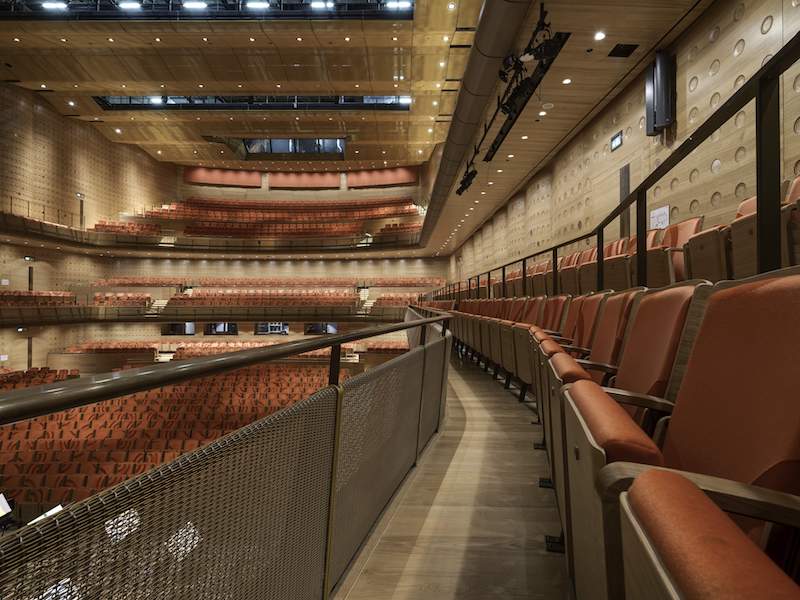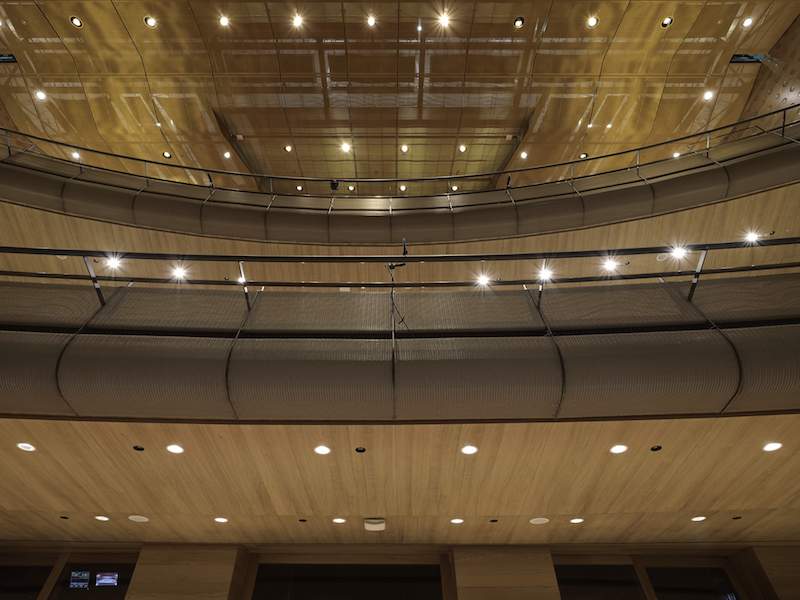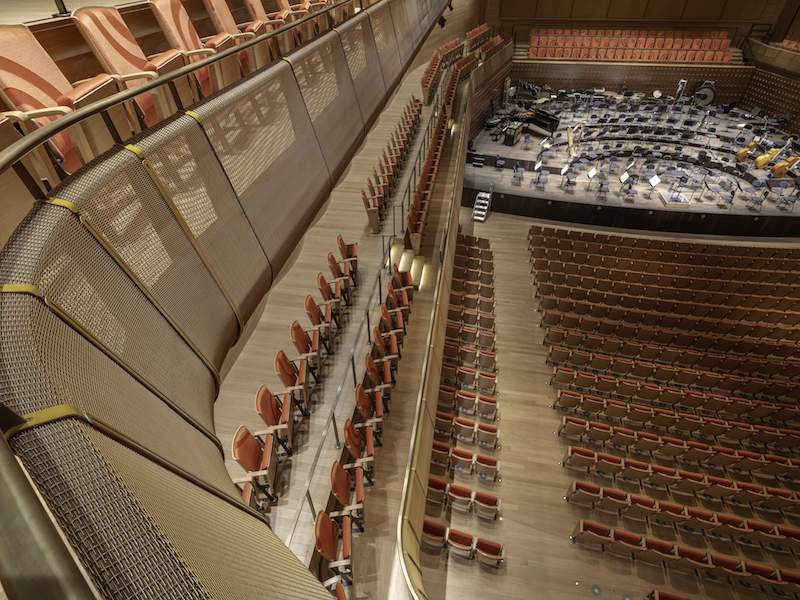The Koningin Elisabethzaal, located in Antwerp, Belgium, is unique in every aspect. Located at the heart of the city center, the concert hall opened its doors in 1897 and has hosted an immensely varied history of performances. During WWI, the building served as a hospital ward, and later hosted boxing and wrestling during the 1920 summer Olympics. The concert hall was reopened in 1960 after major deconstruction following WWII. The fan-shaped building, although multi-faceted, was never fully intended to be a concert hall. Because of this, the acoustics greatly suffered, achieving only six out of ten points on the standard acoustic rating scale. When it was decided to finally redesign the building, one goal was to finally offer a home to the Antwerp Symphony Orchestra. It was time to rebuild.
 Reflectors clad in metal fabric by GKD as well as frames covered in the same fabric ensure a magnificent sound experience.
Reflectors clad in metal fabric by GKD as well as frames covered in the same fabric ensure a magnificent sound experience.
With acoustics being top of mind, Kirkegaard Associates knew it was time to reach out to GKD – Gebr. Kufferath AG. Prior to selecting the materials used for the redesign, Kirkegaard Associates carried out extensive tests on acoustic materials, including GKD’s acoustic products, to ensure the chosen product helped to provide the best possible sound and space experience. The decisive factor in opting for GKD’s metal fabric was the acoustic neutrality. Additionally, the look, flexibility and robust quality of GKD’s fabric measured up to the ambitious design concept of the hall. Once chosen, GKD was involved in the planning process with the architects and acousticians from an early stage. When redesigning the concert hall, the planners first decided to reduce its size to optimize acoustics. A shoebox design was chosen, as classical music lovers deem that design to guarantee optimum acoustics. One of the many elements aimed to enhance acoustics in the hall are movable reflectors suspended from the ceiling clad in metal fabric.
 Semitransparent metal fabric by GKD conceil the bare ceiling and the technical installations above of the Koningin Elisabethzaal.
Semitransparent metal fabric by GKD conceil the bare ceiling and the technical installations above of the Koningin Elisabethzaal.
The same fabric covers frames throughout, including the back wall of the stage, to ensure sound unfolds through the entire building. For the ceiling and stage wall, GKD installed gold-colored, powder-coated Alu 6010 metal fabric. A total of 204 frames, some wave-shaped, were fitted totaling 1,600 square meters of fabric. Ceiling fabric was fitted with cutouts for lights measured exactly to specifications. To fit the balustrades of the hall galleries, GKD selected its Omega 1520 fabric with gold-color coated weft. The fabric was flexible to the bidirectional-curved corners of the balustrade while remaining resistant to impact. When fitting the front and rear of the balustrade elements with 400 square meters of this fabric GKD selected a slightly conical panel cut to follow the curve exactly. The clever interaction between the design of the hall shape, ceiling, wall, and balustrade is what gives the new Koningin Elisabethzaal its excellent acoustics: with 9.3 out of 10 points on the rating scale, it is considered almost perfect.
 The GKD-fabric fits flexibly to the bidirectionally curved corners of the balustrade.
The GKD-fabric fits flexibly to the bidirectionally curved corners of the balustrade.
GKD
Since 1925, GKD has manufactured the most advanced technical weaving mill of metal fabrics for filtration and industrial use. As the company grew, we applied this technology to architecture to unlock new design elements for architects. To this day, GKD continues to revolutionize how architectural structures are enhanced aesthetically, augmented functionally and optimized economically. In this specific case, our aim was to highlight how GKD uses vast experience in metal weaving and coloring to create connections between architecture and individuals. We hope this information can help unlock new solutions for architects, and help them implement their design and functional visions in new ways. Visit us at http://www.gkdmetalfabrics.com/.
GKD-USA, Inc.
825 Chesapeake Drive
Cambridge, MD USA 21613
1 (888) 585-5693
Related Stories
Sponsored | Metals | Jul 20, 2015
Life cycle assessment, and why you should care
LCA is a way of quantifying the environmental impact generated by the manufacture and delivery of a product.
Sponsored | Metals | Jul 8, 2015
Metal Roof Retrofits: the potential, the problems, the payoff, part 2
During metal roof retrofits, look for moisture and check for asbestos
Sponsored | Metals | Jul 7, 2015
Cost efficient solution for confidence-boosting Camp For All
With donations as the charitable foundation's main source of income, camp facilities need to be affordable
Sponsored | Metals | Jun 30, 2015
Understanding heat energy
Thermal convection occurs when hot molecules move from one location to another.
Sponsored | Metals | Jun 23, 2015
Metal Roof Retrofits: the potential, the problems, the payoff, part 1
For the best possible outcomes when working on metal roof retrofits, consider some simple but vital steps to get the best possible outcome from your retrofit job.
Sponsored | Metals | Jun 16, 2015
Metal building products deliver endless design freedom and sustainability
Numerous metal building products contain recycled content, reducing the need to mine new materials and saving space in landfills
Sponsored | Coatings | Jun 15, 2015
What’s in a coating, and why does it matter?
When the sun starts swinging punches at your building's coating, chalking and fading will start. But there's a way to prevent it.
Sponsored | Metals | Jun 9, 2015
How architects can tap into the expertise of their metal roof manufacturer, part 4
Let’s look at the importance of enforcing the detailed specifications the roof manufacturer provides.
Sponsored | Metals | Jun 4, 2015
How big of a building do I need?
Here is some advice on how metal buildings can be a solution for space shortages
















